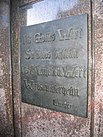Luther Monument (Lutherstadt Wittenberg)
The Luther Monument in Lutherstadt Wittenberg has been a monument that has stood on the town's market square since 1821 and is intended to commemorate the reformer Martin Luther . It is the first monument of its kind in Germany in which a non-noble person was publicly honored with a free-standing statue. The bronze figure comes from Johann Gottfried Schadow , the cast iron canopy from Karl Friedrich Schinkel .
Historical context
Around 1806, when the French occupied the then Saxon fortress of Wittenberg, the planning of a memorial for Martin Luther began. A patriotic literary society in Mansfeld , the city in which Luther spent a large part of his childhood, announced a competition, but it remained unsuccessful. After the Congress of Vienna , Wittenberg came to Prussia after the conquest in 1814. In 1816, for the 300th anniversary of Luther's posting of the theses on the castle church door , the Prussian King Friedrich Wilhelm III. the planning for a Luther monument itself, although the Hohenzollern were Calvinist . A religious reform to a united Protestant church in Prussia with the king as head was imminent in 1817. A committee consisting of Johann Gottfried Schadow, Karl Friedrich Schinkel and Martin Friedrich Rabe was set up and had the task of planning the monument, but did not come to a common conclusion. For the first time in a monument project, the question arose of how a non-noble person should be presented in public. Until then, statues were only reserved for princes and generals.
Construction work
The king therefore decided, contrary to the previous view, that Schadow's design of a free-standing bronze figure should be carried out. The statue depicts Luther bareheaded in his robe , with the open Bible in his hands. The pages on which the Old Testament ends and the New begins are shown. You can read: The New Testament translated into German by Doctor Martin Luther . The foundation stone was laid on October 31, 1817, the day of the Reformation . At the event, the Crown Prince, who later became King Friedrich Wilhelm IV, suggested that Schinkel should design a canopy for the Luther figure. Schinkel delivered his design in early 1818, and in the same year the parts were cast in the Royal Prussian Iron Foundry in Berlin. The memorial was completed in 1821 and was unveiled on Reformation Day. Schadow's figure rests on a stone, cubic base, at the corners of which are octagonal pillars that support the canopy. The cross-shaped roof of the helmet sits on this cross-shaped floor plan, which has corresponding octagonal pillars . The four pillars and the hanging wall of the helmet are eight tabernacles provided where double finials are attached. Gothic-style iron tracery with three passes is inserted in the gable fields . The memorial survived unscathed, restorations were carried out in 1967, 1998 and 2009-2013.
Artistic interpretation
The innovation that bourgeois people can certainly be thought of using still images has been relativized by Schinkel's canopy. Luther is not free, but is in a room. The free statue was therefore still reserved for the nobles. The Luther monument in Wittenberg is seen by the public as the work of the sculptor Johann Gottfried Schadow, so Schinkel's contribution is only an accessory.
- Base inscriptions
- North side: Founded by the Mannsfeld association for / Luther's monument through collected / contributions and erected by King / Friedrich Wilhelm III
- East side: If it is God's work, it will endure, if it is human work, it will perish
- South side: Believe in the gospel
- West side: A solid castle is our God
literature
- Mario Titze: Prussia and Luther. Two 19th century Luther memorials in Wittenberg , Preservation of Monuments in Saxony-Anhalt 1/1996, pp. 62–74
- Helmut Caspar: Schadow's Blücherdenkmal in Rostock and Martin Luther in Wittenberg , series of publications by the Schadow Society, Volume 5, Berlin 2003
- Hilbert Ibbeken, Elke Blauert (eds.): Karl Friedrich Schinkel - the architectural work today , Stuttgart / London 2001
Web links
Individual evidence
- ↑ Fatherland Literary Society of the County of Mansfeld (ed.): D. Martin Luther's monument or contributions to the correct assessment of the company to erect a worthy monument to this great man , Halle, no date.
- ^ Andreas Bernhard: Karl Friedrich Schinkel - Guide to his Buildings, Volume II, Munich, Berlin 2008, p. 50
- ^ Andreas Bernhard: Karl Friedrich Schinkel - Guide to his buildings, Volume II, Munich, Berlin 2008, p. 51
Coordinates: 51 ° 51 '59.7 " N , 12 ° 38' 36.7" E


